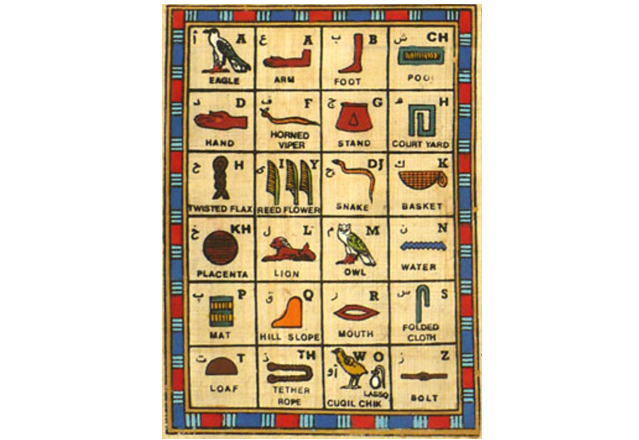Do you want to know how to read hieroglyphs perfectly? Write your name in hieroglyphs?
That's perfect, as enthusiasts of ancient Egypt we are here to help you!
A hieroglyph can be translated either as a letter, a sound or a whole word. So, to start reading ancient hieroglyphs you need to know the 24-letters Egyptian alphabet.
We will discover together in this article:
- The 24-letter Egyptian alphabet
- The different types of other hieroglyphs (and their meanings)
- The different "simplified forms of hieroglyphs"
After reading this article, you will be able to read hieroglyphs as well as an experimented scribe of ancient Egypt.
Let's discover the mystery of hieroglyphs' writing right away.
1) The hieroglyphics' alphabet
A) Hieroglyphs letters
 As in our alphabet, some hieroglyphs in Egyptian writing represented one letter, making up an alphabet of 24 letters (compared with 26 today). These symbols are called phonograms.
As in our alphabet, some hieroglyphs in Egyptian writing represented one letter, making up an alphabet of 24 letters (compared with 26 today). These symbols are called phonograms.
You will notice that in the papyrus-alphabet presented above, there are cases where two of the same phonetic signs translate different sounds (the letter "Y" for example expressed by two "I" symbols). There are also cases where certain letters are represented by several symbols (the vowel "A" is represented by both "arm" and "eagle").
B) Hieroglyphs syllable
Some hieroglyphs represented a full syllable of two or three letters. These hieroglyphs are also called "phonograms". They are for example sounds like "sha" or "ch".
C) The other types of hieroglyphs
The "determiners" define the additional symbols added at the end of a word to change their meaning (thus having the same function as suffixes in our modern language). There are three kinds of determiners:
- Those used to differentiate homonyms such as "bight/bite", "hoes/hose" and "hi/high" to avoid misunderstandings when several words are written in the same way.
- Those used to mark the gender (masculine/feminine) of a word. Placed at the end of a word, the "man" symbol marks the masculine while the "woman" symbol marks the feminine.
- Those used to mark the number (singular/plural). Egyptian words are initially written in the singular. To put them in the plural, simply add three "stick" symbols at the end of the word. In our modern language, it is a bit like adding an "s" at the end of a word.
D) Hieroglyphs number
 According to Egyptologists, the Egyptians also used specific hieroglyphs to designate numbers. Their system of numbers was based on a scale from zero to nine like ours (as seen above).
According to Egyptologists, the Egyptians also used specific hieroglyphs to designate numbers. Their system of numbers was based on a scale from zero to nine like ours (as seen above).
For numbers greater than 9, they changed symbols instead of adding 0s as we do today, namely:
- A pharaonic heel bone for 10
- A spool of rope for 100
- A water lily for 1,000
- A bent finger for 10,000
- A tadpole for 100,000
- The Egyptian god Heh for 1,000,000
E) Hieroglyphs complete word
 In some cases, the hieroglyph represents a complete word. These symbols are called ideograms or logograms.
In some cases, the hieroglyph represents a complete word. These symbols are called ideograms or logograms.
You can see in the image above, that the green ideographic symbol "mountain" simply means the word "mountain". The same is true for the symbols "woman" and "man". Some symbols can represent more than one word depending on the context in which they are used and the other symbols that surround them. For example, the symbol used for "Sun" can also mean "light" and "opportunity".
2) Writings derived from hieroglyphs
Although very pleasing to look at, hieroglyphs writing was much less pleasing to the ancient Egyptians who were responsible for its daily use. For this reason, various increasingly simplified hieroglyphic writings emerged in the Nile valley.
A) Linear hieroglyphs
Linear hieroglyphs are hieroglyphs that are no longer intended to be true works of art. Less worked but faster to draw, they can save a lot of time for a scribe.

B) Hieratic writing
In hieratic writing, the symbols represented are only pieces of hieroglyphs. They completely lose their representative role to become even more practical. This writing was used mainly by the Egyptian administrative system and in the field of culture (for literary and scientific purposes).
 As you can see in the table above, hieratic writing allows somebody to write at least 4 to 5 times faster. A saving of time thus invaluable if one places oneself on the scale of the Egyptian civilization which, with this writing, will only need two scribes to carry out the work of ten!
As you can see in the table above, hieratic writing allows somebody to write at least 4 to 5 times faster. A saving of time thus invaluable if one places oneself on the scale of the Egyptian civilization which, with this writing, will only need two scribes to carry out the work of ten!
3) The discovery of hieroglyphs
We owe the understanding of the hieroglyphic writing system to Jean-François Champollion, a French historian and linguist, considered to be the father of the science devoted to Egyptian civilization: Egyptology.
At the age of 16, Champollion already knew and mastered six ancient oriental languages in addition to Latin and ancient Greek. In his lifetime, the intrepid Egyptologist Champollion was quickly obsessed with deciphering Egyptian hieroglyphs.
Indeed, the translation of these beautiful Egyptian antiquities was lost during the fall of the Roman Empire. To achieve his goal, Champollion used the Rosetta Stone on which we can read the decree establishing the beginning of the reign of the Egyptian pharaoh Ptolemy V. This decree (known as the "Memphis Decree") will help Champollion immensely since it is written in both Greek and Egyptian in the form of hieroglyphs.
